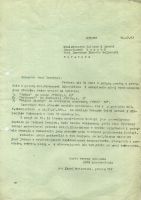Modus for trombone / cello solo (1980/82)
Modus, written in 1980 primarily for trombone solo, and performed in this version by Jim Fulkerson [James Orville Fulkerson], an American trombonist, in the Hilversum Radio, was transcribed in 1982 for cello solo. The work ends with a quotation from Calami sonum ferentes by Cipriano de Rore.
This commentary on his piece was included by Tomasz Sikorski in the Warsaw Autumn programme booklet. Modus was performed for the first time in Poland during a night-time Festival concert at the Academy of Music concert hall (19 September 1983) by the eminent cellist Ivan Monighetti. A few years later the composer’s collaboration with this artist led to the writing of The Silence of the Sirens, also for cello solo.
Moduscomes from the last period of Sikorski’s work, when the composer was focused on chords, harmonic relations between notes, all kinds of phenomena occurring when notes were combined or clashed. This strand in his experiments evolved naturally from a characteristic feature of his previous works, i.e. exploration of the essence of a single note – its sound and its nature.
Lasting just over eight minutes, the composition consists of five parts of varying length, with the shortest lasting 20 seconds and the longest over 4 minutes. Part I of Modus bears a slight resemblance to Monodia from Monodia e Sequenza written over a decade earlier. Both works contain characteristic phrases comprising long notes played increasingly quietly (from f to p), with a short initial phrase containing several notes of short values as well as strong contrasts in terms of dynamics and articulation. Both works even begin with a similar long note on the same pitch (Monodia – B flat1, Modus – A sharp1).
Part II (misterioso), played pianissimo with the bow very near to the bridge (sul ponticello), is a short reminiscence of Part I: a momentary, fleeting and mysterious memory, a fragile, openwork structure that seems to be at breaking point. The next section comprises seven phrases of varying length each time leading to a minim at B flat1 (the pitch that begins the work). Given their rising direction and ending on the highest note, they seem to be questions without answers.
Part IV is the longest and takes up about a half of the composition’s length. It consists of modules based on material from the previous parts repeated two, three or four times. The whole ends with a fragment entitled religioso based on a theme from Calami sonum ferentes, which is a rising succession of seconds from B to F sharp1. A second voice comes in bar four, reintroducing the theme. This unison canon quickly dies out. However, the theme is shown once again, an octave higher, which confirms the listener’s impression that it is the starting point and the basis for the whole composition.



